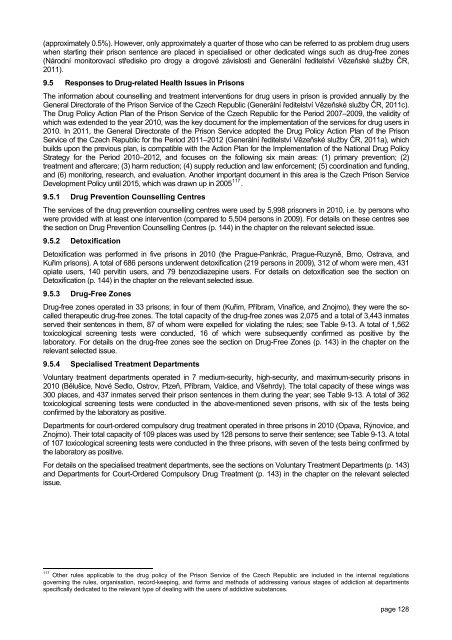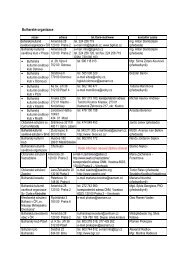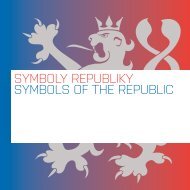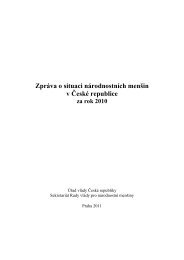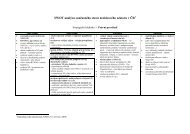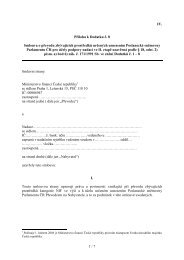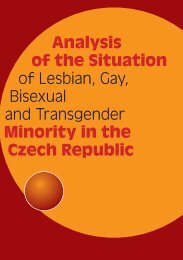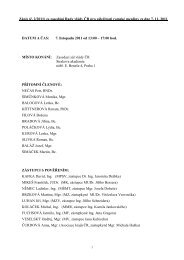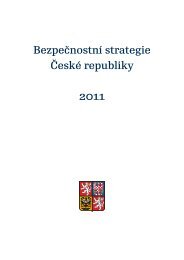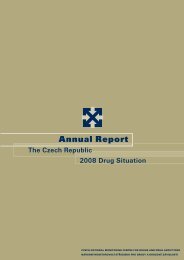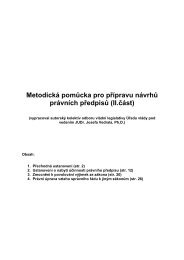The Czech Republic Annual Report 2010 Drug ... - Drogy-info.cz
The Czech Republic Annual Report 2010 Drug ... - Drogy-info.cz
The Czech Republic Annual Report 2010 Drug ... - Drogy-info.cz
Create successful ePaper yourself
Turn your PDF publications into a flip-book with our unique Google optimized e-Paper software.
(approximately 0.5%). However, only approximately a quarter of those who can be referred to as problem drug users<br />
when starting their prison sentence are placed in specialised or other dedicated wings such as drug-free zones<br />
(Národní monitorovací středisko pro drogy a drogové závislosti and Generální ředitelství Vězeňské služby ČR,<br />
2011).<br />
9.5 Responses to <strong>Drug</strong>-related Health Issues in Prisons<br />
<strong>The</strong> <strong>info</strong>rmation about counselling and treatment interventions for drug users in prison is provided annually by the<br />
General Directorate of the Prison Service of the <strong>Czech</strong> <strong>Republic</strong> (Generální ředitelství Vězeňské služby ČR, 2011c).<br />
<strong>The</strong> <strong>Drug</strong> Policy Action Plan of the Prison Service of the <strong>Czech</strong> <strong>Republic</strong> for the Period 2007–2009, the validity of<br />
which was extended to the year <strong>2010</strong>, was the key document for the implementation of the services for drug users in<br />
<strong>2010</strong>. In 2011, the General Directorate of the Prison Service adopted the <strong>Drug</strong> Policy Action Plan of the Prison<br />
Service of the <strong>Czech</strong> <strong>Republic</strong> for the Period 2011–2012 (Generální ředitelství Vězeňské služby ČR, 2011a), which<br />
builds upon the previous plan, is compatible with the Action Plan for the Implementation of the National <strong>Drug</strong> Policy<br />
Strategy for the Period <strong>2010</strong>–2012, and focuses on the following six main areas: (1) primary prevention; (2)<br />
treatment and aftercare; (3) harm reduction; (4) supply reduction and law enforcement; (5) coordination and funding,<br />
and (6) monitoring, research, and evaluation. Another important document in this area is the <strong>Czech</strong> Prison Service<br />
Development Policy until 2015, which was drawn up in 2005 117 .<br />
9.5.1 <strong>Drug</strong> Prevention Counselling Centres<br />
<strong>The</strong> services of the drug prevention counselling centres were used by 5,998 prisoners in <strong>2010</strong>, i.e. by persons who<br />
were provided with at least one intervention (compared to 5,504 persons in 2009). For details on these centres see<br />
the section on <strong>Drug</strong> Prevention Counselling Centres (p. 144) in the chapter on the relevant selected issue.<br />
9.5.2 Detoxification<br />
Detoxification was performed in five prisons in <strong>2010</strong> (the Prague-Pankrác, Prague-Ruzyně, Brno, Ostrava, and<br />
Kuřim prisons). A total of 686 persons underwent detoxification (219 persons in 2009), 312 of whom were men, 431<br />
opiate users, 140 pervitin users, and 79 benzodiazepine users. For details on detoxification see the section on<br />
Detoxification (p. 144) in the chapter on the relevant selected issue.<br />
9.5.3 <strong>Drug</strong>-Free Zones<br />
<strong>Drug</strong>-free zones operated in 33 prisons; in four of them (Kuřim, Příbram, Vinařice, and Znojmo), they were the socalled<br />
therapeutic drug-free zones. <strong>The</strong> total capacity of the drug-free zones was 2,075 and a total of 3,443 inmates<br />
served their sentences in them, 87 of whom were expelled for violating the rules; see Table 9-13. A total of 1,562<br />
toxicological screening tests were conducted, 16 of which were subsequently confirmed as positive by the<br />
laboratory. For details on the drug-free zones see the section on <strong>Drug</strong>-Free Zones (p. 143) in the chapter on the<br />
relevant selected issue.<br />
9.5.4 Specialised Treatment Departments<br />
Voluntary treatment departments operated in 7 medium-security, high-security, and maximum-security prisons in<br />
<strong>2010</strong> (Bělušice, Nové Sedlo, Ostrov, Plzeň, Příbram, Valdice, and Všehrdy). <strong>The</strong> total capacity of these wings was<br />
300 places, and 437 inmates served their prison sentences in them during the year; see Table 9-13. A total of 362<br />
toxicological screening tests were conducted in the above-mentioned seven prisons, with six of the tests being<br />
confirmed by the laboratory as positive.<br />
Departments for court-ordered compulsory drug treatment operated in three prisons in <strong>2010</strong> (Opava, Rýnovice, and<br />
Znojmo). <strong>The</strong>ir total capacity of 109 places was used by 128 persons to serve their sentence; see Table 9-13. A total<br />
of 107 toxicological screening tests were conducted in the three prisons, with seven of the tests being confirmed by<br />
the laboratory as positive.<br />
For details on the specialised treatment departments, see the sections on Voluntary Treatment Departments (p. 143)<br />
and Departments for Court-Ordered Compulsory <strong>Drug</strong> Treatment (p. 143) in the chapter on the relevant selected<br />
issue.<br />
117<br />
Other rules applicable to the drug policy of the Prison Service of the <strong>Czech</strong> <strong>Republic</strong> are included in the internal regulations<br />
governing the rules, organisation, record-keeping, and forms and methods of addressing various stages of addiction at departments<br />
specifically dedicated to the relevant type of dealing with the users of addictive substances.<br />
page 128


